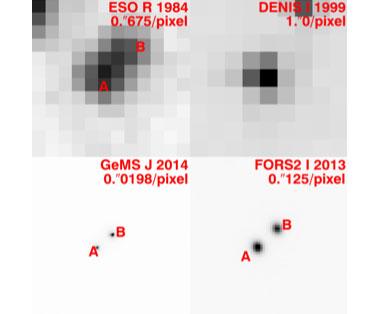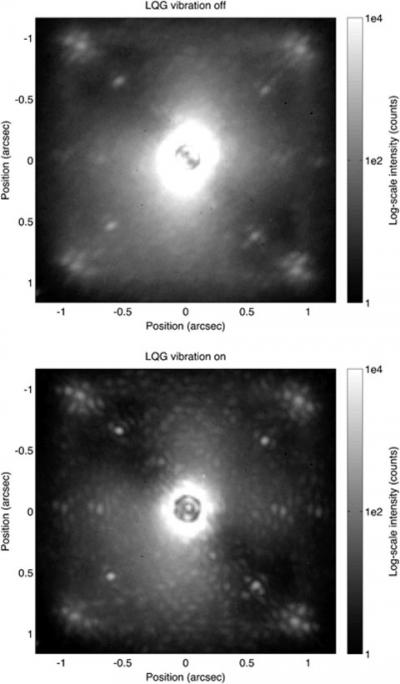Stephen Ammons (14-ERD-076)
Abstract
Until recently, the direct study of exoplanets had plateaued due to the available technology. Only the very youngest planets were visible in the infrared with released gravitational potential energy. Because new capabilities were needed, Livermore developed the Gemini Planet Imager (GPI), the most advanced astronomical adaptive optics system in the world, dedicated to imaging and characterizing extrasolar planets. (The term adaptive optics or AO refers to the use of mirror deformation in optical instruments, such as telescopes, in order to compensate for the distortion caused by the atmosphere, thus improving the performance of the system.) To accomplish the research for this LDRD project, our team had unique access to the GPI when it became operational. We also participated in the Gemini Planet Imager Extra Solar Survey (GPIES) of 900 stars and have discovered the lowest mass Jupiter-like exoplanet ever detected.1 Our team has also advanced high-precision astrometry with AO, constraining the masses of the closest known binary brown dwarf system, Luhman 16.2 The GPI AO performance is now fully characterized3 and the knowledge gained has supported a variety of new programs at Livermore.
Background and Research Objectives
Since 2006, Livermore has led the construction of the $24 million GPI, the most advanced astronomical AO system yet built, designed for discovering and characterizing extrasolar planets. An order of magnitude more sensitive than any existing facility, the GPI can detect a previously unstudied population of young analogs to the giant planets of our solar system and help determine the answer to a key puzzle: How do planetary systems form? As Livermore scientists, we had unique and unfettered early access to this revolutionary instrument.
The GPI is also a uniquely powerful tool for studying the properties of atmospheric turbulence and the optimal adaptive control of those properties. Our team analyzed the behavior of the GPI’s advanced AO system while studying atmospheric turbulence. This allowed us to prototype new advanced optics algorithms, particularly predictive control, which precompensates for the lag between wavefront measurements and correction. These algorithms further enhance the GPI’s performance as well as Livermore’s leading expertise in atmospheric turbulence compensation. These high-performance techniques, though developed for scientific use, in turn are applicable to a broad range of defense scenarios.
This project involved a large international collaboration that carried out a massive survey of more than 600 potential planetary systems using over 900 hours of telescope time, which is the largest single project carried out by an 8-m US telescope. The GPIES team consists of more than 60 members spread out over several countries.
Scientific Approach and Accomplishments
In 2015, GPI campaign observations resulted in the discovery of 51 Eri b, a planet twice the mass of Jupiter orbiting the F0 star 51 Eridani. The detection is clearly visible when we used special photographic methods to capture images in near-infrared wavelengths, namely point-spread-function-subtracted (PSF-substracted), stacked images in the J- and H-band, as well as Lp-band images acquired with Keck NIRC2 (Figure 1). The object spectra display clear methane absorption and are consistent with a low-mass, cloudy planet (Figure 2).
A key parameter in the study of planets is their mass, which is one parameter that in the GPI will not measure directly. Rather, we indirectly measured parameters such as temperature or luminosity that can be combined with evolutionary tracks to produce estimates of planetary masses. An independent measurement of the mass of even a few GPI planets would be extremely powerful – allowing us to estimate the specific entropy of the planet, potentially constrain its equation of state, and distinguish between different formation models. The best way to do this is through the classical gravitational techniques of measuring the reflex motion of the parent star in the plane of the sky by comparison to reference stars.
We tested high precision astrometry for companion mass measurement with an advanced adaptive optics system on the Gemini South Telescope, the Gemini Multi-Conjugate Adaptive Optics System (GeMS). GeMS observations of the closest known binary brown dwarf system, Luhman 16, easily resolved the binary (Figure 3). The observations yielded an estimate of its relative orbit and thus a constraint of the system mass (Figure 4).2 These efforts were led by Livermore postdoctoral scholar E. Victor Garcia.
A significant limitation on GPI’s performance encountered in 2013 was vibration of the telescope's secondary mirror induced by the cryocooler operation. In this project, we developed linear-quadratic Gaussian (LQG) control techniques to suppress the vibration and verified these on-sky.3 The power spectrum density (PSD) maps extracted from wavefront sensor telemetry confirm a tenfold improvement in the vibration amplitude at 37 Hz (Figure 5) resulting in significant improvement in image sharpness (Figure 6).
Impact on Mission
The high-contrast and high-performance techniques for AO developed here with the aid of predictive algorithms of atmospheric turbulence and GPI system simulations are particularly applicable to space surveillance applications such as observations of targets requiring rapid telescope motion or faint sources close to bright targets. This work is relevant to the Laboratory's strategic focus area in cyber security, space, and intelligence to enhance situational awareness for space systems, as well as the core competency in computational science and engineering.
Livermore is one of the leading institutions in the direct detection of exoplanets, and our leadership has been recognized in opportunities such as defining future NASA planet-finding missions.
Our activities complement strategic directions in other areas, including directed energy and space surveillance, by working to build and retain in-house expertise in advanced AO and high-contrast imaging. Predictive AO control improves the imaging contrast of ground-based surveillance telescopes and obviates the need for constructing faster, expensive AO systems for laser directors in high turbulence. Skills gained in specialized coronagraphy (viewing objects close to a star) and accurate wavefront sensing benefit a wide range of problems that require imaging contrast from ground or space.
Conclusion
The GPI is the most advanced AO system in the world. This LDRD project funded the scientific exploitation of the system, resulting in the discovery and imaging of the lowest-mass, Jupiter-like exoplanet yet found, 51 Eri b. The AO system’s performance has been fully characterized and published, and the knowledge gained has benefited other Livermore programs involving high-order AO. The scientists and engineers from this project have been directly involved in 31 peer-reviewed publications and 12 SPIE manuscripts during the project.
References
- Macintosh, B., et al., "Discovery and spectroscopy of the young Jovian planet 51 Eri B with the Gemini Planet Imager." Science. 350, 64 (2015). LLNL-JRNL-678639.
- Garcia, E. V., et al., "Individual, model-independent masses of the closest known brown dwarf binary to the sun." Astrophys. J. Lett., in press (2017). LLNL-JRNL-701044.
- Poyneer, L. A., et al., "Performance of the Gemini Planet Imager's adaptive optics system." Appl. Optic. 55, 323 (2016). LLNL-JRNL-677288.
Publications and Presentations
- Ammons, S. M., et al, "Mapping compound cosmic telescopes containing multiple projected cluster-scale halos." Astrophys. J. 781, 2 (2014). LLNL-JRNL-609412.
- Ammons, S. M., et al., "A measurement of the systematic astrometric error in GeMS and the short-term astrometric precision in ShaneAO." SPIE Astron. Telescope. Instrum. 9148, 1J (2014). LLNL-PROC-657146.
- Ammons, S. M., et al., Advancing high-contrast adaptive optics. Advanced Maui Optical and Space Surveillance Technologies Conference. Maui, HI, Sept. 9–12, 2014. LLNL-PROC-660012.
- Ammons, S. M., and C. Correia, "Tomography in adaptive optics: Ideas, system development, and flourishing." OSA Imaging and Applied Optics: Adaptive Optics: Analysis, Methods & Systems (AO). (2016). LLNL-PROC-696740.
- Ammons, S. M., et al., "Precision astrometry with adaptive optics: towards exoplanet mass measurement from the ground." SPIE Astron. Telescope. Instrum. 9909, 99095T-1 (2016). LLNL-CONF-701398.
- Bailey, V. P., et al., "Status and performance of the Gemini Planet Imager adaptive optics system." SPIE Astron. Telescope. Instrum. 9909, 99090V (2016). LLNL-PROC-697077.
- Barman, T. S., et al., "Simultaneous detection of water, methane, and carbon monoxide in the atmosphere of exoplanet HR 8799 B." Astrophys. J. 804, 61 (2015). LLNL-JRNL-678571.
- Chilcote, J., "The first H-band spectrum of the massive gas giant planet Beta Pictoris B with the Gemini Planet Imager." Astrophys. J. Lett. 798, 3 (2015). LLNL-JRNL-663580.
- de Rosa, R. J., et al., " Astrometric confirmation and preliminary orbital parameters of the young exoplanet 51 Eridani B with the Gemini Planet Manager." Astrophys. J. 814, 3 (2015). LLNL-JRNL-678574.
- de Rosa, R. J., et al., "Spectroscopic characterization of HD 95086 B with the Gemini Planet Manager." Astrophys. J. 824, 121 (2016). LLNL-JRNL-717745. http://dx.doi.org/10.3847/0004-637X/824/2/121
- Dennison, K., and S. M. Ammons, "Modeling a diffractive mask that calibrates optical distortions." PROC SPIE. 9909, 99094E-1 (2016). LLNL-JRNL-695645. http://dx.doi.org/10.1117/12.2233799
- Draper, Z. H., et al., "The peculiar debris disk of HD 111520 as resolved by the Gemini Planet Manager." Astrophys. J. 826, 147 (2016). LLNL-JRNL-717838. http://dx.doi.org/10.3847/0004-637x/826/2/147
- Esposito, T. M., et al., " Bringing 'The Moth' to light: A planet-sculpting scenario for the HD 61005 debris disk." Astron. J. 152, 85 (2016). LLNL-JRNL-717747. http://dx.doi.org/10.3847/0004-6256/152/4/85
- Fox, O. D., et al., "What powers the 3000-day light curve of SN 2006gy?" Mon. Not. R. Astron. Soc. 454, 4366 (2015). LLNL-JRNL-717863. https://academic.oup.com/mnras/article/454/4/4366/1001189
- Garcia, E. V., et al., "SCExAO and GPI YJH Ba." Astrophys. J., in press. (2016). LLNL-JRNL-701012.
- Garrel, V., et al., "Reshaping and polishing the GeMS MCAO system." PROC SPIE. 9909, 99092F-1 (2016). LLNL-PROC-717864. http://dx.doi.org/10.1117/12.2233747
- Hung, L. W., et al., "First scattered-light image of debris disk around HD 131835 with the Gemini Planet Imager." Astrophys. J. 815, 14 (2015). LLNL-JRNL-678635.
- Jensen-Clem, R., et al., "Point source polarimetry with the Gemini Planet Imager. I. sensitivity characterization with T5.5 dwarf companion HD 19467 B." Astrophys. J. Lett. 820, 111 (2016). LLNL-JRNL-678637.
- Johnson-Groh, M., et al., "Integral field spectroscopy of the low-mass companion HD 984 B with the Gemini Planet Imager." Astrophys. J., in press (2016). LLNL-JRNL-717865.
- Kalas, P. G., et al., "Direct imaging of an asymmetric debris disk in the HD 106906 planetary system." Astrophys. J. 814, 32 (2015). LLNL-JRNL-678586.
- Konopacky, Q., et al., "Discovery of a substellar companion to nearby debris hot disk host HR 2562." Astrophys. J. Lett. 829, 4 (2016). LLNL-JRNL-717818. http://dx.doi.org/10.3847/2041-8205/829/1/L4
- Macintosh, B., et al., "The Gemini Planet Imager: First light." Proceedings of the National Academy of Sciences. 111, 12661 (2014). LLNL-JRNL-678638. http://dx.doi.org/10.1073/pnas.1304215111
- Macintosh, B., et al., "Discovery and spectroscopy of the young Jovian planet 51 Eri B with the Gemini Planet Imager." Science. 350, 64 (2015). LLNL-JRNL-678639.
- Millar-Blanchaer, M., et al., "Beta Pictoris inner disk in polarized light and new orbital parameters for Pictoris B." Astrophys. J. 811, 18 (2015). LLNL-JRNL-678640.
- Millar-Blanchaer, M. A., et al., "Imaging an 80 au-radius dust ring around the F5V star HD 157587." Astron. J. 152, 128 (2016). LLNL-JRNL-717861.
- Nielsen, E. L., et al., "Dynamical mass measurement of the young spectroscopic binary V343 Normae AaBb resolved with the Gemini planet imager." Astron. J. 152, 175 (2016). LLNL-JRNL-717862.
- Poyneer, L. A., et al., "Performance of the Gemini Planet Imager's adaptive optics system." Appl. Optic. 55, 323 (2016). LLNL-JRNL-677288.
- Rameau, J., et al., "Constraints on the architecture of the HD 95086 planetary system with the Gemini Planet Imager." Astrophys. J. Lett. 822, 29 (2016). LLNL-JRNL-717744. http://dx.doi.org/10.3847/2041-8205/822/2/L29
- Savransky, D., et al., "Campaign scheduling and analysis for the Gemini Planet Imager." Proc. Intl. Astronomical Union Symp., vol. 299 (2014). LLNL-CONF-640216.
- Wang, J. J., et al., "Gemini Planet Imager observations of the Au Microscopii debris disk: Asymmetries within one arcsecond." Astrophys. J. Lett. 811, 19 (2015). LLNL-JRNL-678601. http://dx.doi.org/10.1088/2041-8205/811/2/L19
- Wang, J. J., et al., "The orbit and transit prospects for a beta pictoris B constrained with one milliarcsecond astrometry." Astron J. 152, 97 (2016) LLNL-JRNL-717857
- Wilson, M. L., et al., "A spectrographic survey of the fields of 28 strong gravitational lenses: The group catalog." Astrophys. J. 833, 194 (2016). LLNL-JRNL-717837.











